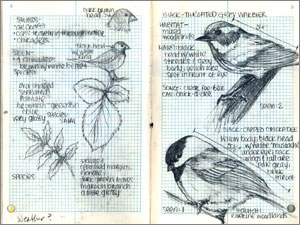 |
Wildlife Module |
|
|
How to Collect Data: MaterialsThe basic materials that are needed to participate in the NatureMapping Wildlife Module are:
MapsTwo topographic maps
A city street or land use map may be helpful, especially if your area is undergoing a lot of growth, and the USGS maps may be outdated. (Check on the bottom of the map for the map preparation date.) Visit the County Assessor or your city Land Planning offices for a copy of their land use maps. Field Guides and other toolsField guides are extremely helpful for identification. Some field guides may
have photographs and Life-sized
silhouettes of wildlife were created for NatureMapping to teach
identification of the "Animal Tracks by Steve" sells stencils that allow you to create life-size tracks and trails while helping you learn details about the tracks and natural history of each animal. Binoculars and CamerasBinoculars are extremely handy, but not mandatory to do NatureMapping. The prices for good 7x35 or 8x20 power binoculars are very affordable. There are 3-power binoculars available for younger children. These are waterproof and less destructible than the higher power binoculars. Cameras are very useful. Pictures of before, during, after, and annual updates are valuable for restoration projects. Make sure you label the photo or name the digital picture with location and date. Pictures of unidentified species can be submitted with the data for positive identification. Field Journals / Notebooks
It is important to record detailed information, whether you are conducting a scientific experiment in a lab or out in the field. We can not remember everything and referring to notes is a critical component of the scientific process. A sketch of the field site (or a photograph) is a handy way to remember your visit. Field notebooks are important if a question arises after you return from the site. It is much better to have notes than try to guess. Data collected in the field notebooks can be transferred to the NatureMapping Data Collection Form. The field notebooks can be plain paper or formatted. Listed below are examples of formatted field notebooks.
Data Submission (Washington State)Wildlife home > |

Sitemap | Contact Us |
|